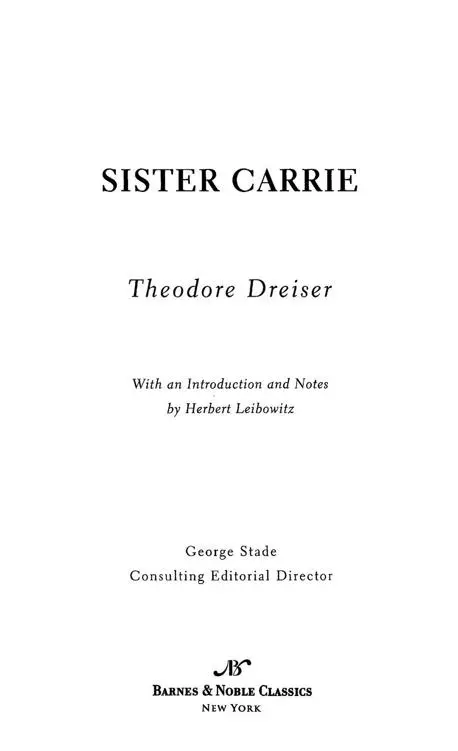I need what little I make to pay for my clothes. I’m leaving twenty dollars. It’s all I have just now. You can do whatever you like with the furniture. I won’t want it.”
(page 388)
Sitting alone, she was now an illustration of the devious ways by which one who feels, rather than reasons, may be led in the pursuit of beauty. Though often disillusioned, she was still waiting for that halcyon day when she should be led forth among dreams become real.
(page 445)


Published by Barnes & Noble Books
122 Fifth Avenue
New York, NY 10011
www.BookishMall.com.com/classics
Sister Carrie was first published in 1900 in an edition of
1,000 copies. It was reissued in 1907.
Published in 2005 by Barnes & Noble Classics with new Introduction; A Note on
Hotels, Homes, Restaurants, and the Theater; Notes; Biography; Chronology;
Inspired By; Comments & Questions; and For Further Reading.
Introduction; A Note on Hotels, Homes, Restaurants,
and the Theater; Notes; and For Further Reading
Copyright © 2005 by Herbert Leibowitz.
Note on Theodore Dreiser, The World of Theodore Dreiser and Sister Carrie,
Inspired by Sister Carrie, and Comments & Questions
Copyright @ 2005 by Barnes & Noble, Inc.
All rights reserved. No part of this publication may be reproduced or transmitted
in any form or by any means, electronic or mechanical, including photocopy,
recording, or any information storage and retrieval system, without the
prior written permission of the publisher.
Barnes & Noble Classics and the Barnes & Noble Classics
colophon are trademarks of Barnes & Noble, Inc.
Sister Carrie
ISBN-13: 978-1-59308-226-0 ISBN-10: 1-59308-226-6
eISBN : 978-1-411-43318-2
LC Control Number 2005927065
Produced and published in conjunction with:
Fine Creative Media, Inc.
322 Eighth Avenue
New York, NY 10001
Michael J. Fine, President and Publisher
Printed in the United States of America
QM
3 5 7 9 10 8 6 4 2
Theodore Dreiser
Theodore Dreiser was born on August 27, 1871, in Terre Haute, Indiana, the ninth of ten children. The family lived in poverty, and his brothers and sisters were rebellious and wild. At age sixteen, Theodore left home for Chicago, where he took a variety of jobs. With the help of a former teacher, he enrolled at Indiana University in 1889, but after a year he left school, aimless and uncertain about his future. By 1892 Dreiser was working as a journalist, first in Chicago and then in St. Louis. He moved to New York City in 1894, took over editorship of a monthly music magazine, and contributed his own editorials, reviews, and articles for publication. He became a prodigious writer, trying his hand at everything from short stories to poetry to drama, and published diverse articles in such popular magazines as Harper’s Monthly, McClure’s, and Cosmopolitan. He married Sara Osbourne White, a schoolteacher, in 1898.
In 1900 Dreiser published his first novel, Sister Carrie, to mixed reviews. The book sold just 500 copies before controversy over its frank treatment of sexual relations and unpunished immorality prompted the publisher to withdraw it from sale. Dreiser began a second novel but fell into a depression so severe that his brother placed him in a sanatorium to recuperate. Emerging from treatment, Dreiser resumed editing and eventually secured a job as editor-in-chief with Butterick Publications. In 1907 Sister Carrie was reissued and Dreiser’s literary accomplishment acknowledged, but in 1910 a romance with the daughter of a co-worker forced him to resign his post at Butterick. Undaunted, Dreiser completed his second novel, Jennie Gerhardt (1911) and, inspired by its modest success, became a full-time writer.
Never a faithful husband, Dreiser permanently separated from his wife in 1912, but the couple never divorced. Politically, he became involved with the progressive movement, and his writings often focused on social injustice and materialism. Thanks in part to the positive reviews of social critic H. L. Mencken, Dreiser’s literary fame grew, but his publishers frequently censored his controversial style of realism. Dreiser devoted the next several years to various genres, including travel writing, memoirs, philosophical essays, short stories, and even poetry; he also wrote several major novels, including the first two books in the “Trilogy of Desire” series and The “Genius” (1915).
In 1919 Dreiser began an affair with his young cousin, Helen Richardson. They moved to Hollywood, where he began The Bulwark, a novel about the struggles of a Quaker family that would be published in 1946, and sought work in the movie industry. In 1925 he published An American Tragedy, a novel about a sensational murder; his first commercial success, the book won critical acclaim for its fearless, brutally honest observations of American society. In 1927 Dreiser visited the Soviet Union, and during the Great Depression, he was an outspoken critic of capitalism.
1 comment